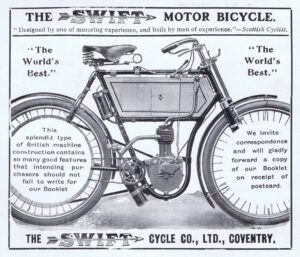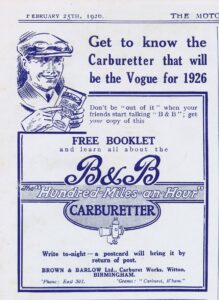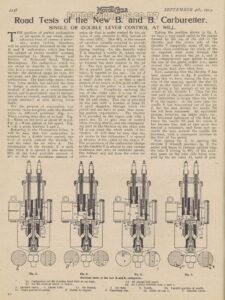The Early Carburating System.
In the very early days of motorcycles, the carburetter consisted merely of a shallow tank containing petrol through which air was drawn on the suction stroke of the engine, the air bubbling through the petrol in its passage, and so taking up or carburating itself with a certain amount of petrol vapour. As may be imagined, this system was very unreliable, so that the surface carburettor, as it was called, soon disappeared in favour of what is known as a spray carburettor. The principle of the spray carburettor, which term will include every type of motorcycle carburettor now made, is extremely simple but it must be admitted that, in spite of this fact, the design of a modern carburettor is still a very difficult process.

Advertisement of a 1903 Swift clearly showing the inlet tube from the surface carburettor built into the front part of the fuel tank leading down to the inlet valve on the engine.
So given the complexities of the carburettor we decided to put up what information we had on some of the various carburettors that were fitted to the various makes of the time. Most of it came from Chapter 4 of the 1919 edition of Motorcycles and How to Manage Them. The list is quite impressive covering a detailed drawing of the two lever B&B carburettor, Triumphs own twin throttle barrel carburettor, B&Bs variable jet carburettor, a Senspray carburettor sectional drawing, the AMAC (Aston Motor Accessories Co), the Binks 3 jet carburettor, the Wolf carburettor with its guaze and wick type jet, BSAs own 2 barrel type with variable jet and the early type Schebler Model H carburettor as fitted to American motorcycles. Really something for everybody.
And of course there are some hints on tuning.
Click on the B&B advertisement below to see the 20 page chapter from what is a very interesting manual.
It is a 4.7M PDF.

An informative page from September 4th, 1913 issue of The Motor Cycle on the road test of the new B&B carburettor with single or double lever. A well written article.

